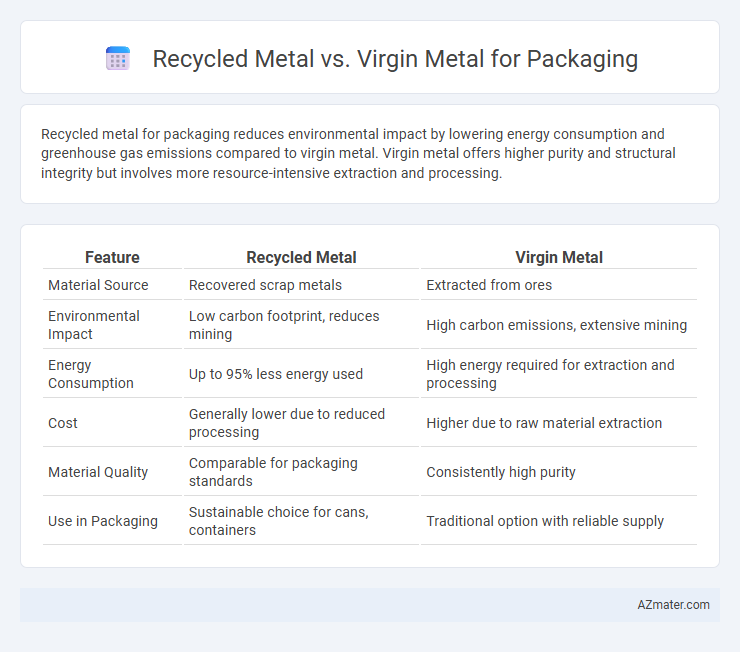Recycled metal for packaging reduces environmental impact by lowering energy consumption and greenhouse gas emissions compared to virgin metal. Virgin metal offers higher purity and structural integrity but involves more resource-intensive extraction and processing.
Table of Comparison
| Feature | Recycled Metal | Virgin Metal |
|---|---|---|
| Material Source | Recovered scrap metals | Extracted from ores |
| Environmental Impact | Low carbon footprint, reduces mining | High carbon emissions, extensive mining |
| Energy Consumption | Up to 95% less energy used | High energy required for extraction and processing |
| Cost | Generally lower due to reduced processing | Higher due to raw material extraction |
| Material Quality | Comparable for packaging standards | Consistently high purity |
| Use in Packaging | Sustainable choice for cans, containers | Traditional option with reliable supply |
Introduction to Metal Packaging
Metal packaging, made from either recycled or virgin metal, plays a crucial role in protecting and preserving products in various industries. Recycled metal offers significant environmental benefits by reducing natural resource extraction and lowering energy consumption compared to virgin metal, which is derived directly from ore mining. The choice between recycled and virgin metal impacts the sustainability, cost, and performance of packaging solutions, driving innovation in metal packaging materials.
Understanding Recycled Metal
Recycled metal in packaging significantly reduces energy consumption and carbon emissions compared to virgin metal production, making it a sustainable choice. Metals like aluminum and steel can be recycled indefinitely without losing their properties, ensuring material efficiency and cost-effectiveness. Utilizing recycled metal supports circular economy practices and minimizes environmental impact by reducing the need for mining and raw material extraction.
What is Virgin Metal?
Virgin metal refers to metal extracted directly from natural ore through mining and refining processes, untouched by previous manufacturing cycles. It possesses a pristine molecular structure, offering consistent quality and strength ideal for packaging applications requiring high durability and purity. While virgin metal ensures reliability, it typically consumes more energy and natural resources compared to recycled metal, impacting environmental sustainability.
Environmental Impact: Recycled vs Virgin Metal
Recycled metal in packaging reduces energy consumption by up to 95% compared to virgin metal production, significantly lowering greenhouse gas emissions. Utilizing recycled metals also decreases mining activities, preserving natural ecosystems and reducing soil and water pollution. Packaging made from recycled metals supports circular economy practices, minimizing landfill waste and conserving finite raw materials.
Energy Consumption in Metal Production
Recycled metal in packaging production consumes up to 95% less energy compared to virgin metal extraction and processing, significantly reducing the environmental footprint. The energy-intensive processes of mining, refining, and smelting virgin metals contribute substantially to greenhouse gas emissions, whereas recycled metal requires melting and reprocessing, which demands much less energy. Utilizing recycled metals in packaging not only conserves natural resources but also enhances energy efficiency, supporting sustainable manufacturing practices.
Quality and Performance in Packaging
Recycled metal in packaging offers comparable strength and durability to virgin metal while significantly reducing environmental impact and production energy consumption. Virgin metal provides a consistent chemical composition and pristine material properties, ensuring optimal barrier protection and mechanical performance in packaging applications. Advances in recycling technology increasingly minimize impurities in recycled metals, enhancing their quality to meet rigorous packaging standards without compromising functionality.
Cost Comparison: Recycled vs Virgin Metal
Recycled metal for packaging significantly reduces raw material costs, often costing 20-40% less than virgin metal due to lower energy consumption and reduced extraction expenses. Virgin metal pricing fluctuates based on mining, refining, and environmental compliance costs, making it generally more expensive and volatile. Choosing recycled metal not only lowers production costs but also minimizes environmental impact, enhancing overall sustainability in packaging operations.
Supply Chain and Availability
Recycled metal in packaging significantly reduces supply chain volatility by utilizing secondary raw materials that are more consistently available than virgin ore, which is subject to mining disruptions and geopolitical risks. The availability of recycled metals depends heavily on efficient collection and sorting systems, enabling stable input flows for packaging manufacturers. Virgin metals require extensive extraction processes with longer lead times and higher environmental costs, often impacting supply predictability and price stability in global markets.
Regulatory and Industry Standards
Recycled metal packaging must comply with strict regulatory standards such as the FDA's guidelines in the United States and the European Union's Packaging and Packaging Waste Directive, ensuring safety and material integrity. Industry standards like the Aluminum Association's certification programs and the Institute of Scrap Recycling Industries (ISRI) specifications mandate quality and traceability for recycled metals to prevent contamination and maintain performance. Virgin metals typically meet more consistent purity levels but face increasing regulatory pressure to incorporate recycled content to promote sustainability and reduce carbon footprints.
Future Trends in Metal Packaging
The future of metal packaging is increasingly driven by the demand for recycled metals due to their lower carbon footprint and energy consumption compared to virgin metals. Innovations in recycling technologies are enhancing the quality and durability of recycled metal, making it more viable for high-performance packaging applications. Growing regulatory pressures and consumer preferences for sustainability are accelerating the shift towards recycled metal, positioning it as a key material in the evolving circular economy of metal packaging.

Infographic: Recycled metal vs Virgin metal for Packaging
 azmater.com
azmater.com